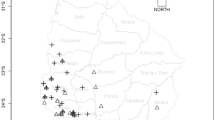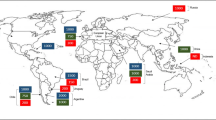Abstract
Fusarium species causing maize kernel rot are major threats to maize production, due to reduction in yield as well as contamination of kernels by mycotoxins that poses a health risk to humans and animals. Two-hundred maize kernel samples, collected from 20 major maize growing areas in Ethiopia were analyzed for the identity, species composition and prevalence of Fusarium species and fumonisin contamination. On average, 38 % (range: 16 to 68 %) of maize kernels were found to be contaminated by different fungal species. Total of eleven Fusarium spp. were identified based on morphological characteristics and by sequencing the partial region of translation elongation factor 1-alpha (EF-1α) gene. Fusarium verticillioides was the dominant species associated with maize kernels (42 %), followed by F. graminearum species complex (22.5 %) and F. pseudoanthophilium (13.4 %). The species composition and prevalence of Fusarium species differed among the areas investigated. Fusarium species composition was as many as eight and as few as four in some growing area. The majority of the maize samples (77 %) were found positive for fumonisin, with concentrations ranging from 25 μg kg−1 to 4500 μg kg−1 (mean: 348 μg kg−1 and median: 258 μg kg−1). Slight variation in fumonisin concentration was also observed among areas. Overall results indicate widespread occurrence of several Fusarium species and contamination by fumonisin mycotoxins. These findings are useful for intervention measures to reduce the impact of the main fungal species and their associated mycotoxins, by creating awareness and implementation of good agricultural practices.






Similar content being viewed by others
References
Araṅkacāmi, I., & Rangaswamy, R. (1995). A text book of agricultural statistics. New Delhi: New Age International Publisher Ltd..
Ayalew, A. (2010). Mycotoxins and surface and internal fungi of maize from Ethiopia. African Journal of Food, Agriculture, Nutrition and Development, 10, 4109–4123.
Battilani, P., Pietri, A., Barbano, C., Scandolara, A., Bertuzzi, T., & Marocco, A. (2008). Logistic regression modeling of cropping systems to predict fumonisin contamination in maize. Journal of Agricultural and Food Chemistry, 56, 10433–10438.
Bii, F., Wanyoike, W., Nyende, A., Gituru, R., & Bii, C. (2012). Fumonisin contamination of maize (Zea mays) in aflatoxin ‘hot’zones in Eastern Province of Kenya. African Journal of Health Sciences, 20, 28–36.
Central Statistical Agency of Ethiopia (CSA) (2012). Reports on area and crop production forecasts for major grain crops (for private peasant holding, Meher season). Statistical Bulletin. http://www.csa.gov.et/images/general/news/2006%20forecast.pdf. Accessed 11 July 2014.
Doohan, F., Brennan, J., & Cooke, B. (2003). Influence of climatic factors on Fusarium species pathogenic to cereals. European Journal of Plant Pathology, 109, 755–768.
Dorn, B., Forrer, H. R., Jenny, E., Wettstein, F. E., Bucheli, T. D., & Vogelgsang, S. (2011). Fusarium species complex and mycotoxins in grain maize from maize hybrid trials and from grower's fields. Journal of Applied Microbiology, 111, 693–706.
EU Commission (2006). Commission Regulation (EC) No. 1881/2006 of 19 December 2006 setting maximum levels for certain contaminants in foodstuffs. Official Journal of the European Union, L364/5- L364/24.
Fandohan, P., Zoumenou, D., Hounhouigan, D., Marasas, W., Wingfield, M., & Hell, K. (2005). Fate of aflatoxins and fumonisins during the processing of maize into food products in Benin. International Journal of Food Microbiology, 98, 249–259.
Food and Drug Administration (FDA) (2001). Guidance for industry fumonisin levels in human foods and animal feeds, final guidance. http://www.fda.gov/food/guidanceregulation/guidancedocumentsregulatoryinformation/ucm109231.htm. Accessed 02 June 2013.
Geiser, D. M., del Mar Jimenez-Gasco, M., Kang, S., Makalowska, I., Veeraraghavan, N., Ward, T. J., et al. (2004). FUSARIUM-ID v. 1.0: a DNA sequence database for identifying Fusarium. European Journal of Plant Pathology, 110, 473–479.
Gelderblom, W., Snyman, S., Abel, S., Lebepe-Mazur, S., Smuts, C., Van der Westhuizen, L., et al. (1996). Hepatotoxicity and-carcinogenicity of the fumonisins in rats. Advances in Experimental Medicine and Biology, 392, 279–296.
Geleti, D., Tolera, A., Mengistu, S., Demisse, K., & Esatu, W. (2011). Improving the fodder contribution of maize-based farming systems in Ethiopia: approaches and some achievements. In W. Mossisa et al. (Eds.), Meeting the challenges of global climate change and food security through innovative maize research (pp. 272–281). Addis Ababa: CIMMYT.
Goertz, A., Zuehlke, S., Spiteller, M., Steiner, U., Dehne, H. W., Waalwijk, C., et al. (2010). Fusarium species and mycotoxin profiles on commercial maize hybrids in Germany. European Journal of Plant Pathology, 128, 101–111.
Halstensen, A. S., Nordby, K.-C., Klemsdal, S. S., Elen, O., Clasen, P.-E., & Eduard, W. (2006). Toxigenic Fusarium spp. as determinants of trichothecene mycotoxins in settled grain dust. Journal of Occupational and Environmental Hygiene, 3, 651–659.
Harrison, L. R., Colvin, B. M., Greene, J. T., Newman, L. E., & Cole, J. R. (1990). Pulmonary edema and hydrothorax in swine produced by fumonisin B1, a toxic metabolite of Fusarium moniliforme. Journal of Veterinary Diagnostic Investigation, 2, 217–221.
Kellerman, T. S., Marasas, W., Thiel, P., Gelderblom, W., Cawood, M., & Coetzer, J. A. (1990). Leukoencephalomalacia in two horses induced by oral dosing of fumonisin B1. Onderstepoort Journal of Veterinary Research, 57, 269–275.
Leslie, J. F., & Summerell, B. A. (2006). The Fusarium laboratory manual. Ames: Blackwell publishing.
Logrieco, A., Mule, G., Moretti, A., & Bottalico, A. (2002). Toxigenic Fusarium species and mycotoxins associated with maize ear rot in Europe. European Journal of Plant Pathology, 108, 597–609.
Mesterházy, Á. K., Lemmens, M., & Reid, L. M. (2012). Breeding for resistance to ear rots caused by Fusarium spp. in maize–a review. Plant Breeding, 131, 1–19.
Ministry of Agriculture and Rural Development (MoARD) (2005). Major Agro-ecological Zones of Ethiopia. Addis Ababa: Forestry, Land Use and Soil Conservation Department.
Missmer, S. A., Suarez, L., Felkner, M., Wang, E., Merrill Jr., A. H., Rothman, K. J., et al. (2006). Exposure to fumonisins and the occurrence of neural tube defects along the Texas-Mexico border. Environmental Health Perspectives, 114, 237–241.
Munkvold, G. P. (2003). Epidemiology of Fusarium diseases and their mycotoxins in maize ears. European Journal of Plant Pathology, 109, 705–713.
Ncube, E., Flett, B. C., Waalwijk, C., & Viljoen, A. (2011). Fusarium spp. and levels of fumonisins in maize produced by subsistence farmers in South Africa. South African Journal of Science, 107, 1–7.
Nirenberg, H.I. (1976). Untersuchungen über die morphologische und biologische Differenzierung in der Fusarium-Sektion Liseola. Mitteilungen aus der Biologischen Bundesanstalt Fur Land- und Forstwirtschaft, Berlin-Dahlem, 169, 1–117.
O’Donnell, K., Kistler, H. C., Cigelnik, E., & Ploetz, R. C. (1998). Multiple evolutionary origins of the fungus causing Panama disease of banana: concordant evidence from nuclear and mitochondrial gene genealogies. Proceedings of the National Academy of Sciences, 95, 2044–2049.
Picot, A., Barreau, C., Pinson-Gadais, L., Caron, D., Lannou, C., & Richard-Forget, F. (2010). Factors of the Fusarium verticillioides-maize environment modulating fumonisin production. Critical Reviews in Microbiology, 36, 221–231.
Pitt, J., Taniwaki, M. H., & Cole, M. (2013). Mycotoxin production in major crops as influenced by growing, harvesting, storage and processing, with emphasis on the achievement of food safety objectives. Food Control, 32, 205–215.
Reddy, K., Salleh, B., Saad, B., Abbas, H., Abel, C., & Shier, W. (2010). An overview of mycotoxin contamination in foods and its implications for human health. Toxin Reviews, 29, 3–26.
Reyes-Velázquez, W. P., Figueroa-Gómez, R. M., Barberis, M., Reynoso, M. M., Rojo, F. G., Chulze, S. N., et al. (2011). Fusarium species (section Liseola) occurrence and natural incidence of beauvericin, fusaproliferin and fumonisins in maize hybrids harvested in Mexico. Mycotoxin Research, 27, 187–194.
Scauflaire, J., Mahieu, O., Louvieaux, J., Foucart, G., Renard, F. & Munaut, F. (2011). Biodiversity of Fusarium species in ears and stalks of maize plants in Belgium. European Journal of Plant Pathology, 131, 59–66.
Sundheim, L., & Tsehaye, H. (2015). Fumonisin in Zambia and neighboring countries in a changing climate. Advances in Environmental Research, 39, 69–84.
Sydenham, E. W., Thiel, P. G., Marasas, W. F., Shephard, G. S., Van Schalkwyk, D. J., & Koch, K. R. (1990). Natural occurrence of some Fusarium mycotoxins in corn from low and high esophageal cancer prevalence areas of the Transkei, southern Africa. Journal of Agricultural and Food Chemistry, 38, 1900–1903.
Vigier, B., Reid, L. M., Seifert, K. A., Stewart, D. W., & Hamilton, R. I. (1997). Distribution and prediction of Fusarium species associated with maize ear rot in Ontario. Canadian Journal of Plant Pathology, 19, 60–65.
Waśkiewicz, A., Beszterda, M., & Goliński, P. (2012). Occurrence of fumonisins in food-an interdisciplinary approach to the problem. Food Control, 26, 491–499.
Acknowledgments
This research was financially supported by the Norwegian Agency for Development Cooperation (NORAD) via the inter University collaboration between the Norwegian University of Life Sciences (UMB) and Mekelle University (MU) through the MU-UMB (NORAD-phase III) project. The authors also thank the Ethiopian Ministry of Agriculture and Rural Development for supplying agroecological GIS data and the metrological service agency for supplying the metrological data.
Author information
Authors and Affiliations
Corresponding author
Rights and permissions
About this article
Cite this article
Tsehaye, H., Brurberg, M.B., Sundheim, L. et al. Natural occurrence of Fusarium species and fumonisin on maize grains in Ethiopia. Eur J Plant Pathol 147, 141–155 (2017). https://doi.org/10.1007/s10658-016-0987-6
Accepted:
Published:
Issue Date:
DOI: https://doi.org/10.1007/s10658-016-0987-6




